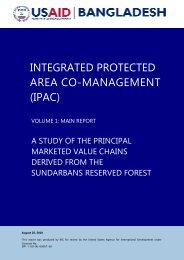Child Equity Atlas - BIDS
Child Equity Atlas - BIDS
Child Equity Atlas - BIDS
Create successful ePaper yourself
Turn your PDF publications into a flip-book with our unique Google optimized e-Paper software.
Situation in Urban Areas: The Case of Dhaka City Corporation<br />
Situation in Urban Areas: The Case of Dhaka City<br />
Corporation<br />
6.0.0 Urbanization is both a cause and<br />
consequence of economic growth. The world<br />
is increasingly becoming urban because<br />
urbanization is an irreversible and dynamic<br />
process interlinked with socioeconomic change.<br />
Bangladesh is experiencing one of the most rapid<br />
urbanization progressions in Asia, at a rate of 3.0 per<br />
cent per annum 23 , as more and more people flock<br />
to the city from rural areas, seeking opportunities,<br />
fleeing from socioeconomic and environmental<br />
vulnerabilities in the rural economy.<br />
6.0.1 In 1974, about one in every 10 persons<br />
lived in urban areas (8.8 per cent) 24 of the<br />
country. While in 2011, about one in every four<br />
persons (23.3 per cent) 25 are living in urban<br />
areas. As the country is one of the poorest<br />
and most densely populated countries in the<br />
world, the rapid urbanization in the country is<br />
causing tremendous pressure on its existing<br />
infrastructure and basic civic facilities.<br />
6.0.2 Dhaka city population has grown from<br />
two to over six million between 1974 and<br />
2011, with the area under the city corporation<br />
increasing from about 300 to over 1500 sq.km.<br />
during the same period 26, 27 . Like Lagos, Dhaka<br />
is one of the fastest growing cities in the world,<br />
at annual rate of 3.2 per cent, which translates<br />
23<br />
World Development Indicators, 2011, http://data.worldbank.org/indicator/SP.URB.GROW<br />
24<br />
Bangladesh Population and Housing Census, 2001<br />
25<br />
Bangladesh Population and Housing Census, 2011<br />
26<br />
Rapid Urban Growth and Poverty in Dhaka City; http://<br />
www.bangladeshsociology.org/BEJS%205.1%20Rapid%20<br />
Urban%20Growth%20and%20Poverty%20final.pdf<br />
27<br />
Bangladesh Population and Housing Census, 2011<br />
to about 300,000 to 400,000 migrants each year,<br />
according to the World Bank (2007 28 ).<br />
6.0.3 Despite the global financial problems,<br />
Bangladesh continues to record impressive<br />
economic growth of about 6 per cent GDP in<br />
recent years (6.23 per cent in fiscal year 2011/2012<br />
according to the Bangladesh Bureau of Statistics 29 ).<br />
The quality of growth and the social inclusiveness<br />
is a vital consideration in growing economies,<br />
such as Bangladesh which aspires to the middle<br />
income status by 2021. The social outcomes of<br />
economic growth on population most vulnerable<br />
to deprivation represents one dimension of<br />
gauging the quality of growth, and a call to action<br />
to end the pockets of poverty, while celebrating<br />
the areas of progress.<br />
6.0.4 In our estimation the highest population<br />
growth in Dhaka city is in the slums where<br />
according to UNICEF 30 , indicators of children’s<br />
socioeconomic rights are worse than in rural areas,<br />
challenging the so called trickledown effect of<br />
rapid economic growth.<br />
6.0.5 Hence, the 2011 Population and Housing<br />
Census presents a unique opportunity to understand<br />
the population dynamics during the last<br />
decade and to uncover the deprivation and<br />
disparities normally hidden in the national averages.<br />
28<br />
World Bank, Dhaka: Improving Living Conditions for the<br />
Urban Poor, Bangladesh Development Series, Paper No. 17,<br />
Dhaka, 2007.<br />
29<br />
Bangladesh Bureau of Statistics, http://www.bbs.gov.bd/<br />
WebTestApplication/userfiles/Image/BBS/GDP_2012_13.pdf<br />
30<br />
UNICEF Bangladesh, 2010 Understanding Urban Inequality<br />
in Bangladesh: A prerequisite for achieving Vision 2021.<br />
http://www.unicef.org/bangladesh/Urban_paper_lowres.pdf<br />
81














